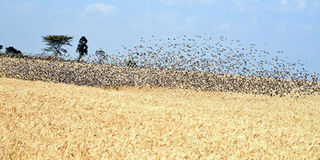Quelea birds bring misfortune to Narok farmers

Quelea birds invade a wheat field in Narok County on September 19, 2018. Such invasion costs the agriculture sector huge losses. PHOTO | FILE | NATION MEDIA GROUP
What you need to know:
- The Narok County and national governments spent Sh200 million fighting the bird through aerial spraying of wheat fields with avicide.
- The Food and Agriculture Organisation estimates the annual agricultural loss attributable to the Quelea to be in excess of $50 million (Sh5bn).
Saitalok ole Kudate’s 20-acre wheat farm in Nairasirasa, Narok County, stretches a golden brown as far as the eye can see, and seems to meet the sky on the horizon.
The scene is breathtaking, save for the polythene bags hanging intermittently on strings tied to electricity posts and the few surviving trees. They are hang when harvest time approaches to scare away Quelea birds.
But, Mr Kudate says this strategy no longer works. Not even the traditional scarecrows work anymore. Consequently, the birds have consumed hundreds of acres of grain in the vast county.
Perhaps what Mr Kudate does not know is that governments in East and Central Africa have spent millions of shillings on boardroom discussions as well as on the field trying to fight the tiny bird, which measures about 12 centimetres in length and weighs 15-26 grammes.
What makes them a constant threat to sorghum, wheat, barley, millet and rice fields is their huge numbers.
EABL AT RISK
Just this month, the Narok County and national governments spent Sh200 million fighting the bird through aerial spraying of wheat fields with avicide.
But, the problem now is the impact of the chemicals on the environment, how it will affect fields, rivers and homes.
Besides, the effectiveness of the strategy is doubtful, since the highly migratory bird is not restricted to any region and moves across Africa seeking areas where there is little disruption.
Last Thursday, Mr Vincent Okwaro, the chairperson of Obudo Border Co-operative Society in Nyando, Kisumu County, expressed fears that an invasion by the birds could see their sorghum harvests fall, and possibly lead to East African Breweries Limited not receiving enough grain to meet its production demand.
African nations have over the years spent huge amounts of money strategising on how to eliminate the bird, which, according to Africa Geographic, destroys thousands of tonnes of wheat, millet and sorghum every year.
SOLUTIONS
On April 4, 2017, 13 nations met in Khartoum, Sudan, to discuss the effects of the bird’s invasions on harvests and how to control it without harming the environment.
The United Nation's Food and Agriculture Organisation (Fao and 20 nations dedicated huge sums of money to the meeting.
It is estimated that there are 5.5 billion queleas in Africa, and that flocks ranging from 1 million to 5 million can consume 50 tonnes of grain a day.
Last week, the State Department for Crops Development’s Plant Protection Services reported that a Quelea invasion had destroyed 57,000 hectares of wheat and was still destroying some more.
QUELEA PROFILE
A report compiled by migratory pest management expert Stanley Kipkoech after a survey that began on the fifth of this month indicated that the birds have the potential to damage 151,730 kgs of wheat in a day, translating to a Sh137 million loss per day; since a kilo of rice goes for Sh30 in the area.
“The wheat will be in the field for another 30 days, during which it is vulnerable to damage by the birds,” Mr Kipkoech said in the report that sought to justify the need for aerial avicide spraying of 60,000 hectares (150,000 acres) of wheat currently in the field.
The red-billed Quelea is a small weaver bird native to sub-Saharan Africa, and the most numerous bird species in the world.
The Centre for Agriculture and Biosciences International (CABI) profile of the bird, in its invasive species compendium, says the Quelea is inherently nomadic, following rain fronts.
It is this migratory nature that sees it invade areas where it was previously absent.
MIGRATION PATTERN
Before arriving in Kenya in late June, the birds were spotted in Lake Natron in Tanzania, where millet and sorghum had matured, ready for harvest.
The Journal of Avian Biology says migration patterns of the red-billed Quelea have been the focus of intense research, since the species is a major crop pest in Africa.
They are long-distance migrants, with a range covering well over 10 million square kilometre.
“The direction and timing of migration are believed to be controlled by the seasonal passage of rain fronts across Africa,” it says.
It believes that before migrating to the area around Lake Natron, the birds had invaded rice fields in Mwea, Kirinyaga County, destroying thousands of acres.
The Fao estimates the annual agricultural loss attributable to the Quelea to be in excess of $50 million (Sh5bn).
Environmentally, the bird is profiled to be influential in the destruction and creation of acacia bush, as their nitrogen-rich droppings promote grass growth and can have a positive impact on biodiversity since it can be food for a variety of mammals, birds and reptiles.





